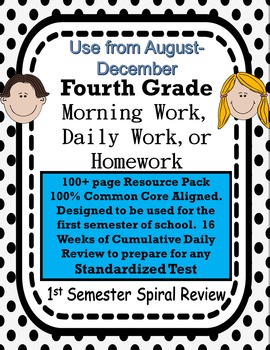4th Grade Morning Work Common Core August-December
Kathryn Willis
4.7k Followers
Grade Levels
4th
Subjects
Resource Type
Standards
CCSS4.MD.A.1
CCSS4.MD.A.2
CCSS4.MD.A.3
CCSS4.MD.B.4
CCSS4.MD.C.5
Formats Included
- PDF
Pages
117 pages
Kathryn Willis
4.7k Followers
Description
This is a resource packet full of 100+ pages of morning work/daily work/homework. It was designed using fourth grade common core standards and designed to be used during the 1st and 2nd quarters based on the Curriculum pacing guide. It is 100% aligned to the Common Core Standards. There are 16 weeks worth of work. This is an amazing way to have a quick preparation for you standardized test.
These resources are a great review and each week focuses on the same skills in reading and math. This was designed so that every Friday or fifth day could be a formative assessment to see what your students have mastered or what they might need more work on.
This daily work is effective and a great cumulative review before any standardized test.
For example, there will be four specific standards in language and four specific standards in math in each week. Every day will be a question for students to answer in regard to each standard.
The way it is used in my personal classroom is that we review the morning work together Mon-Thurs. On Friday, I will take them up. This gives me a wonderful idea a to which students have mastered or need work on each of the standards.
Friday’s morning work can either be used as a grade, or just as an observation to know where students are with each standard.
MORNING WORK FROM JAN-MAY 4th GRADE COMMON CORE IS AVAILABLE:
4th Grade Morning Work Jan-May
These resources are a great review and each week focuses on the same skills in reading and math. This was designed so that every Friday or fifth day could be a formative assessment to see what your students have mastered or what they might need more work on.
This daily work is effective and a great cumulative review before any standardized test.
For example, there will be four specific standards in language and four specific standards in math in each week. Every day will be a question for students to answer in regard to each standard.
The way it is used in my personal classroom is that we review the morning work together Mon-Thurs. On Friday, I will take them up. This gives me a wonderful idea a to which students have mastered or need work on each of the standards.
Friday’s morning work can either be used as a grade, or just as an observation to know where students are with each standard.
MORNING WORK FROM JAN-MAY 4th GRADE COMMON CORE IS AVAILABLE:
4th Grade Morning Work Jan-May
Total Pages
117 pages
Answer Key
N/A
Teaching Duration
1 Semester
Report this resource to TPT
Reported resources will be reviewed by our team. Report this resource to let us know if this resource violates TPT’s content guidelines.
Standards
to see state-specific standards (only available in the US).
CCSS4.MD.A.1
Know relative sizes of measurement units within one system of units including km, m, cm; kg, g; lb, oz.; l, ml; hr, min, sec. Within a single system of measurement, express measurements in a larger unit in terms of a smaller unit. Record measurement equivalents in a two-column table. For example, know that 1 ft is 12 times as long as 1 in. Express the length of a 4 ft snake as 48 in. Generate a conversion table for feet and inches listing the number pairs (1, 12), (2, 24), (3, 36),...
CCSS4.MD.A.2
Use the four operations to solve word problems involving distances, intervals of time, liquid volumes, masses of objects, and money, including problems involving simple fractions or decimals, and problems that require expressing measurements given in a larger unit in terms of a smaller unit. Represent measurement quantities using diagrams such as number line diagrams that feature a measurement scale.
CCSS4.MD.A.3
Apply the area and perimeter formulas for rectangles in real world and mathematical problems. For example, find the width of a rectangular room given the area of the flooring and the length, by viewing the area formula as a multiplication equation with an unknown factor.
CCSS4.MD.B.4
Make a line plot to display a data set of measurements in fractions of a unit (1/2, 1/4, 1/8). Solve problems involving addition and subtraction of fractions by using information presented in line plots. For example, from a line plot find and interpret the difference in length between the longest and shortest specimens in an insect collection.
CCSS4.MD.C.5
Recognize angles as geometric shapes that are formed wherever two rays share a common endpoint, and understand concepts of angle measurement:





